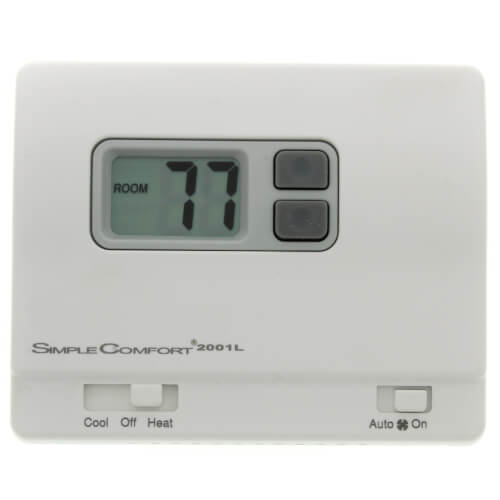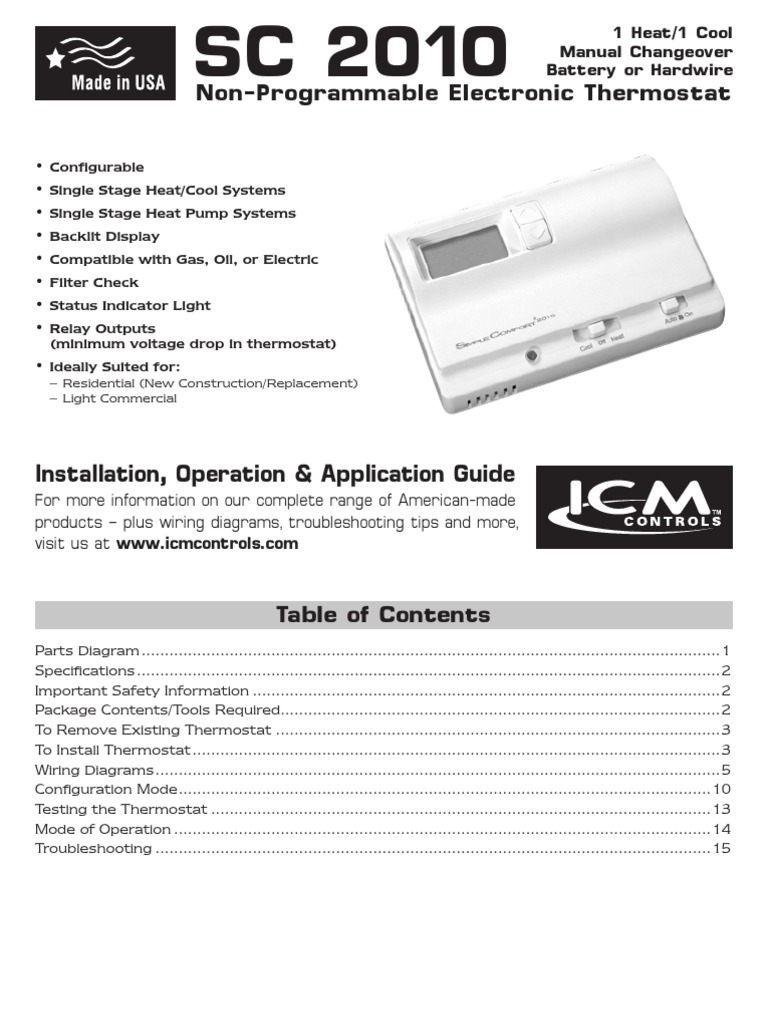Simple Comfort 2001 Thermostat Manual
SC2001L. Non-Programmable. Single-stage heat/cool or single-stage heat pump. New ICM patented Thermal Intrusion Barrier.
- Simple Comfort 2001 Thermostat Owners Manual
- Simple Comfort 2001 Thermostat Manual
- Simple Comfort Thermostat Instruction Manual
Elegant design. Simple operation. Zoning system compatible. Adjustable temperature differential. Large backlit LCD display. Hardwired. Precise temperature sensing.
Easy access terminal block. 4- or 5-wire compatible. Freeze protection feature. High temperature 'run away' heat protection. Mercury-free, environmentally safe. Manual changeover. Soft touch controls.
With central cooling or heating systems controlling temperatures at our homes, offices, shopping malls and even car and buses, the relevance of air conditioning systems and their maintenance has grown. The thermostat is one very vital component of all controlled temperature systems, and most of the system's problems can be attributed to issues in the thermostat. The Thermostat Explained Have you ever noticed air conditioning systems switching on and off by themselves?
If you have a conventional electric oven, you must have observed that heating coils stop heating after some time. Why does this happen and what causes it? It happens because in both the cases mentioned above, there is a manually set temperature, which when attained, a device turns the system off, thereby stopping the flow of heat, so that a desired set temperature can be maintained. The device responsible for regulating the temperature is called a thermostat. So now, you can imagine that any problem with thermostat can cause a lot of discomfort. Without it, one will have to control the temperatures manually, whenever we feel too hot or too cold.
So, let's quickly take a look at the problems and troubleshooting for a thermostat. Most Common Thermostat Problems First signs of problems with a thermostat include drop in performance of the temperature regulating system, and can make you feel too warm or too cold. Before calling out an A/C repair professional, it can be worthwhile to look at the thermostat yourself. Location The most important factor you need to see is the place of installation. If you have the thermostat mounted on a wall with a high thermal coefficient, then such a device will fail to offer you comfortable temperature, as it will never react properly to the air in the room. But instead, it will clock the temperature of the walls.
Similarly, if they are installed at places where there's direct sunlight or near an outside door or window, you will face a similar problem. Ideally, a thermostat's installation should be close to where the filter is, so that it can sense and react to the temperature in the air handler. Make sure there is no hole or empty space behind the thermostat. Such a space can feed cool or warm air currents to its back. If you happen to notice a big hole at the back of the thermostat, you can stuff some insulation in this hole, like cotton gauze, or cover it with non-conducting tape.
On mechanical (non-digital) thermostats, a heat anticipator is installed which needs to be set in accordance to the current draw on the thermostat circuit. This anticipator may need periodic manual adjustments with the help of an amp meter to get a proper setting. Power Supply Some thermostats, mostly digital ones, use battery power for their functioning. It might be a simple case of the battery getting discharged, or a malfunctioning of the battery recharging system. Inspect the batteries and replace them if required. Some digital thermostats are designed for AA batteries, or if there are back lights, then they may use AAA batteries. In case you think that the charger has some issues, make sure to check the power switch circuit breaker in the battery charging circuit.
Most thermostats used in homes are powered by 24 volts AC, and this power is derived from an air handler and heating split system. Such thermostats are known to be equipped with a power stealing technology. In such cases, it is better to first check the circuit breaker meant for the air handler and make sure it is not tripped.
Simple Comfort 2001 Thermostat Owners Manual

It is not uncommon for people to forgo these circuit breakers and that is when they think the thermostat is out of order. Loosely-wired or Miswired HVAC systems are not to be trifled with. A lot of people get the notion that they can fix a broken thermostat, as it is just a matter of twiddling with a few wires. Chances are, they'll end up smoking the control boards or the transformer. Unless you have good experience in HVAC installations, I strongly advise that you get your thermostat looked up by a professional. Because you're not just messing with a piece of electrical equipment that costs a decent chunk of money, you're risking your own self while tinkering with it. In fact, you'll often come across forums that deny any DIY help to people who are new to this, because they know the risk involved.
Simple Comfort 2001 Thermostat Manual
And while we're at it, in no case will you open up the thermostat while the power is still on. Make you you trip not only the outer breakers, but the inner home breakers as well. Programming Defects These days, most A/C systems are equipped with programmable thermostats. The biggest problem in such devices is their RAM-like programming chips. These thermostat chips lose their programming whenever there is an abrupt power failure. To get rid of this situation, you need to reprogram the chip, but it will meet a similar ending whenever there's another power failure. These days newer programmable thermostats are available which have a ROM memory which does not perish with a power failure.
Simple Comfort Thermostat Instruction Manual

But, if the old system does not support these new programmable thermostats, the only option is to go for conventional battery powered ones. These are the major problems which are highly prevalent in air conditioning systems.
Even though temperature control systems have become technologically superior, improper usage and non-standard installation can damage the system and cause trouble.
Recent Posts
- Kawasaki Zx14 2016 Service Repair Manual
- 2016 Monte Carlo Repair Manual
- Advanced Excel 2017 Manual
- Lifan Engine Atv Repair Manual
- 1998 Vtr1000 Superhawk Owners Manual
- Renault Scenic 03 Manual
- 2017 Holden Rodeo Ra Workshop Manual
- 2015 Mercury 50 Hp 2 Stroke Manual
- 4le1 Service Manual
- Grove 522 Crane Manuals
- 980h Bucket Parts Manual
- Peugeot Partner Service Manual 2015
- Cost Accounting Weygandt Solutions Manual
- Honeywell Webs User Guide
- Polaris 330 Shop Manual
- Chemical Kinetics And Reaction Dynamics Solutions Manual





